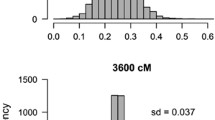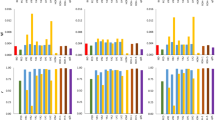Abstract
The effective number of breeders (N b) for a cohort of progeny can be estimated from an excess of heterozygotes that arises in progeny produced by finite numbers of parents. In principle, N b is a simple function of the standardized deviation (D) of the proportion of heterozygous progeny from its expectation under random mating. We explored the sampling properties of this D-estimator of N b through computer simulation. The accuracy of the D-estimator is remarkably robust to variation in numbers of alleles and loci and the presence of rare alleles, though precision can be low if, relative to a given N b, the sample of progeny or the cumulative number of independent alleles (n ci) sampled is too small. For N b up to 30 parents, acceptable accuracy is achieved with sample sizes of 200 or more progeny and 80 or more independent alleles; for N b of 50–100, a sample of 500–1,000 progeny and 450–900 independent alleles are required for similar accuracy and precision. Though the estimator is most applicable for the situation of random union of gametes (as may occur in some marine invertebrates or fish, for example), it works for other mating systems (monogamous or polygamous pairings, polygyny), when the effective number of breeders is small (N b ≤ 20). Simulations reveal small overestimation biases with smaller sample sizes, rare alleles, or highly polymorphic loci (≥10 alleles). Despite this bias, multiallelic loci are preferable to many loci with few alleles, which have larger sampling errors.



Similar content being viewed by others
References
Balloux F (2004) Heterozygote excess in small populations and the heterozygote-excess effective size. Evolution 58:1891–1900
Falconer DS (1989) Introduction to quantitative genetics, 3rd edn. Longman Scientific & Technical with J Wiley & Sons, Inc., New York
Fan JB, Chee MS, Gunderson KL (2006) Highly parallel genomic assays. Nat Rev Genet 7:632–644. doi:10.1038/nrg1901
Hedgecock D (1994) Does variance in reproductive success limit effective population size of marine organisms? In: Beaumont AR (ed) Genetics and evolution of aquatic organisms. Chapman and Hall, London, pp 122–134
Hedgecock D, Launey S, Pudovkin AI, Naciri Y, Lapègue S, Bonhomme F (2007) Small effective number of parents (N b) inferred for a naturally spawned cohort of juvenile European flat oysters Ostrea edulis. Mar Biol (Berl) 150:1173–1183. doi:10.1007/s00227-006-0441-y
Hedrick P (2005) Large variance in reproductive success and the N e /N ratio. Evolution 59:1596–1599
Launey S, Barre M, Gerard A, Naciri-Graven Y (2001) Population bottleneck and effective size in Bonamia ostrea–resistant populations of Ostrea edulis as inferred by microsatellite markers. Genet Res Camb 78:259–270
Levitan DR, Sewell MA, Chia FS (1992) How distribution and abundance influence fertilization success in the sea-urchin Strongylocentrotus franciscanus. Ecology 73:248–254. doi:10.2307/1938736
Luikart G, Cornuet J (1999) Estimating the effective number of breeders from heterozygote excess in progeny. Genetics 151:1211–1216
Mead KS, Denny MW (1995) The effects of hydrodynamic shear-stress on fertilization and early development of the purple sea-urchin Strongylocentrotus purpuratus. Biol Bull 188:46–56. doi:10.2307/1542066
Morin PA, Luikart G, Wayne RK (2004) SNPs in ecology, evolution and conservation. Trends Ecol Evol 19:208–216. doi:10.1016/j.tree.2004.01.009
Pudovkin AI, Zaykin DV, Hedgecock D (1996) On the potential for estimating the effective number of breeders from heterozygote-excess in progeny. Genetics 144:383–387
Rasmussen DI (1979) Sibling clusters and gene frequencies. Am Nat 113:948–951. doi:10.1086/283449
Robertson A (1965) The interpretation of genotypic ratios in domestic animal populations. Anim Prod 7:319–324
Tallmon DA, Koyuk A, Luikart G, Beaumont MA (2008) ONeSAMP: a program to estimate effective population size using approximate Bayesian computation. Mol Ecol Resour 8:299–301. doi:10.1111/j.1471-8286.2007.01997.x
Waples RS (1991) Genetic methods for estimating the effective size of cetacean populations. In: Hoelzel AR (ed) Genetic ecology of whales and dolphins. Intl. Whaling Comm, London, pp 279–300 Special Issue 13
Waples RS, Do C (2008) LDNE: a program for estimating effective population size from data on linkage disequilibrium. Mol Ecol Resour 8:753–756. doi:10.1111/j.1755-0998.2007.02061.x
Zhdanova OL, Pudovkin AI (2008) The program NB_HetExcess to estimate small N b from genotype frequencies in the progeny. J Hered 99:694–695. doi:10.1093/jhered/esn061
Acknowledgments
The authors thank Robin S. Waples for encouragement throughout the course of this study and for comments on an earlier draft of this paper. We also thank two anonymous reviewers for constructive criticisms. DH was supported in part by the National Science Foundation, grant no 0412696.
Author information
Authors and Affiliations
Corresponding author
Rights and permissions
About this article
Cite this article
Pudovkin, A.I., Zhdanova, O.L. & Hedgecock, D. Sampling properties of the heterozygote-excess estimator of the effective number of breeders. Conserv Genet 11, 759–771 (2010). https://doi.org/10.1007/s10592-009-9865-5
Received:
Accepted:
Published:
Issue Date:
DOI: https://doi.org/10.1007/s10592-009-9865-5




